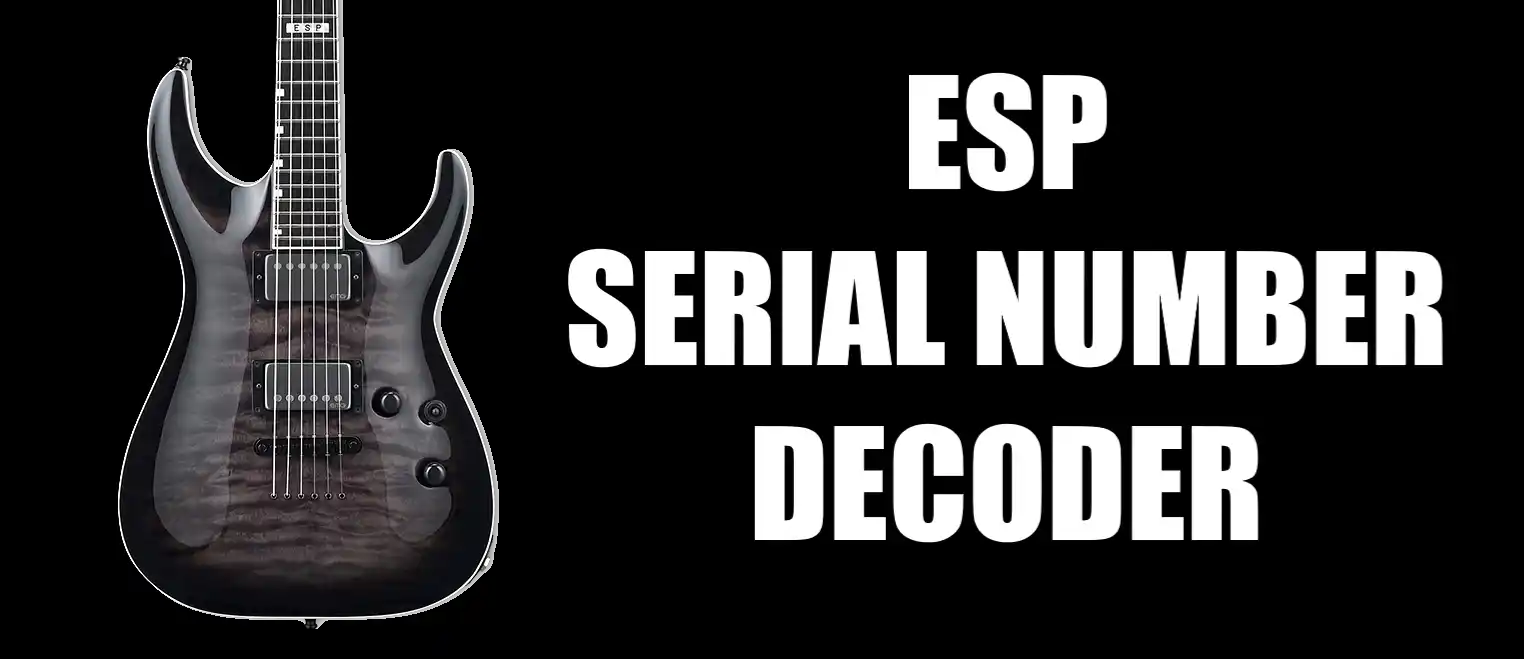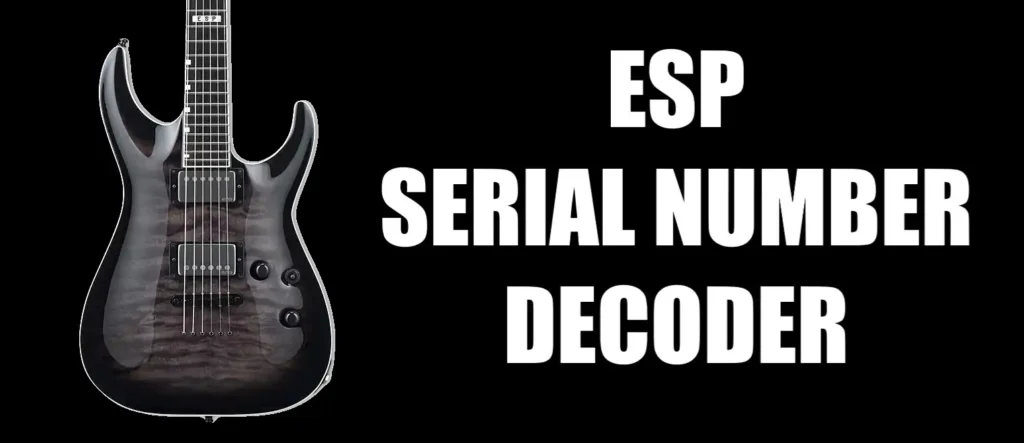
During the early stages of production, ESP guitars were not well documented in terms of their serial numbers. As a result, ESP serial numbers that predate the year 2000 cannot be relied upon to determine an exact date of production.
To determine the production year of your guitar, you can use the serial number Decoder and the manual guide provided below.
Where to Find ESP Serial Number?
The ESP serial number can be found on the back of the headstock, neck plate, or inside the body for acoustic and semi-acoustic guitars.
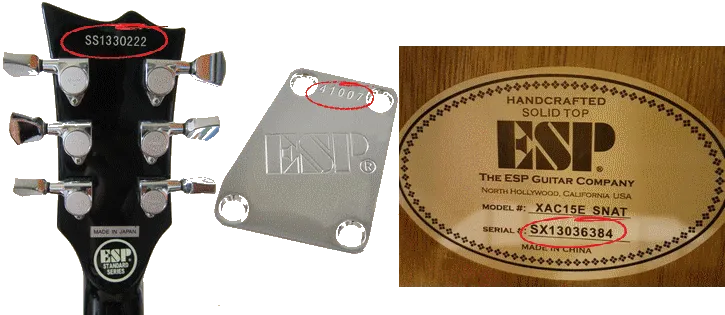
Table of Contents
ESP Serial Number Before 2000
The accuracy of dating guitars produced in the 1980s and 1990s can be problematic due to careless record-keeping. Some models from this era lack serial numbers altogether. Even with neck plate serial numbers, the exact date can be difficult to determine because plates with only the ESP logo were also used. Moreover, numbered plates were often produced in advance and assigned at random.
For guitars without a serial number on the headstock or neck plate, the heel of the neck may contain a serial number that could help with dating.
Another possible location for a serial number is the cavity on the body of the pickups. If a number is found in this location, it can be deciphered using a decoder to determine its date of manufacture.
It’s worth noting that while serial numbers can be helpful in dating guitars, they are not always definitive, and other factors, such as changes made to a guitar over time, can also affect its age.
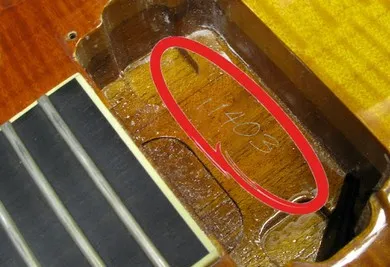
The 8-digit coding system that existed before 2000 looked like this: DDMMYNNN.
DD = day of the month (01 – 31).
MM = month (01 – 12) Y = Last digit of the year.
NNN = production number 000 – 999.
For example: Serial number 25055012 is the 12th guitar built on May 25th, 1995.
ESP Serial Number 2000-2015
After 2000 a serial number system was used which is a lot simpler. It consists of 1 or 2 letters followed by 7 digits.
The letter (s) indicate the location of the manufacturer.
The first 2 digits are the year.
The next 2 digits are the week number, the 5th digit is the day of the week.
The last 2 digits are the production number.
Example: SS1209210.
SS = Custom Shop ESP 12 = 2012.
09 = week number 9.
2 = the 2nd day of week 9.
10 = production number.
So SS1209210 is the 10th guitar, built on February 28, 2012, in the Custom Shop of ESP in Tokyo.
This system was used until 2015.
ESP Serial Number Since 2016
From 2016 another system was introduced. This system consists of 1 letter followed by 7 digits.
The letter is the brand name, E = ESP.
The first 4 digits are the production number.
The next 2 digits are the year, and the last digit is the series type. (1 = Custom series, 2 = Signatures series and 3 = E-II series).
Example: E1234162.
E = ESP, 1234 = production number, 16 = 2016, 2 = Signatures Series.
Kirk Hammett Signature Serial Number
The Kirk Hammett Signature (K- serial number) guitars were initially released as Custom Shop models in 1993, featuring Kirk Hammett’s signature on the front of the headstock and a serial number on the back of the headstock.
The serial number consists of K- followed by either 4 or 5 digits, with the latter introduced after the guitars’ official launch in 1995. Before this, the serial numbers had only 4 digits.
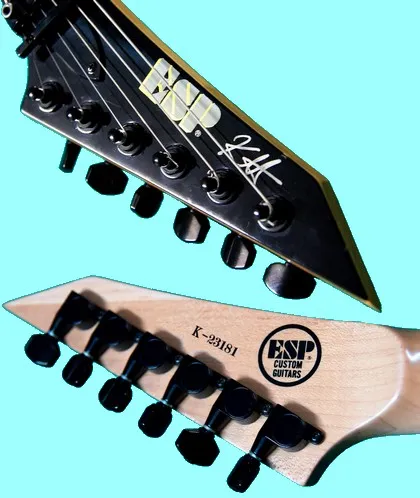
LTD and Asia Serial Numbers
The guitars built in Korea, India, Indonesia, China, and Vietnam use different serial number systems. This makes proper dating difficult. What they do have in common is that the first 2 digits after the letter prefix contain the year.
Production locations:
Letter + 7 digits: E and U = Korea, I = Vietnam, L = China.
2 letters + 7 digits: IS and IR = Indonesia.
Letter + 8 digits: W = World Musical Instrument Co., Incheon, Korea.
2 letters + 8 digits:
IW, IX and IS = Indonesia.
WR and GW = World Musical Instrument Co., Incheon, Korea.
SX, SK, RS, and SP = China.
2 letters + 9 digits. IS = Indonesia.
ESP Serial Number Decoder
Enter the serial number, click the “Check” button and this lookup tool will show you the year when your guitar was made and the country where it came from.
ESP guitars… now that was something that truly set my blood on fire. The first photos of ESP guitars in catalogs completely turned my world upside down. Back then, I was a teenager obsessed with extreme music. Surfing the ESP website and staring at those incredible designs for hours was a ritual, a dream come true! The prices, of course, were out of reach, even for a used one.
Years later, I finally got to hold my dream guitar, the ESP Horizon FR. It was an incredibly beautiful guitar with an amazing sound. But sometimes, it’s better for a dream to remain just that – a dream. After years of playing an Ibanez RG, the Horizon’s archtop and thick neck didn’t feel as comfortable. It wasn’t disappointing, maybe even a relief because if I had loved it as much as I did in those photos, I would’ve had to sell everything I owned to buy that ESP, haha!
